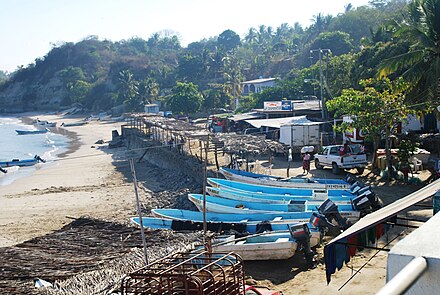Cuajinicuilapa - human settlement in Mexico
Cuajinicuilapa is a town in Guerrero, Mexico. Cualji, as the locals call it, is the home of Afro-Mexicans. Its highlight is a beautiful little museum to the history of Afro-Mexicans in the country.
Understand
Music and dance
The city is deeply rooted in music derived from African rhythms such as the cajón, trough, devils and the traditional Chilean sound. The latter has undergone several modifications in places such as Ometepec, Pinotepa Nacional and Chilpancigo, due to the way of dressing and stomping, on the contrary in Cuajinicuilapa the clothing consisting of a blouse, white with ruffles or chakira embroidery, skirt long and loose in a single color, guaraches, hat and red bandana in the case of women, in men the shirt or white cotton, blanket pants, hat, guaraches and red bandana in hand. Cuajinicuilapa has two own songs, a Chilean one known as "Adiós Cuajinicuilapa" and the second a bolero known as "Cuajinicuilapita", the latter performed by the duet.
Get in
The main way to get to Cuajinicuilapa is by bus. Via 200 runs through the town. The terminal de autobuses is located at the southern end of town on the main highway. It is primarily served by 2nd class buses. Below is a summary of the long distance buses.
- Acapulco with Alta Mar. About 5 times a day. M$198 2015-04-08
- Ciudad De Mexico with Alta Mar. About 3 times a day. M$660-780 2015-04-08
- Puerto Escondido with Alta Mar. About 6 times a day. M$185 2015-04-08
The town can also be reached by minibus/collectivo from nearby city of Pinotepa Nacional (1hr, M$50),
Get around
The town is about a kilometre long, and can be easily seen on foot.
See
- National Museum of Cultures Afromestizo, +52 741 414 1231. M-F 09:00-20:00. A museum of the Afromestizo cultures of the region with maps, models, dioramas, graphics, texts, drawings, documents, engravings, facsimiles, photographs, costumes, masks and musical instruments. 2021-09-02
- The main tourist attraction is Punta Maldonado, also known as El Faro. This is followed by the Santo Domingo lagoon that has extensive mangroves and the so-called Barra del Pío, a virgin beach which is considered the most beautiful in the municipality for its peculiar color of water and extensive lagoon.
Do
Buy
There is a great diversity of artisan products, such as: devil masks, pètate bulls, figures made from coconut shells, accessories made from sea products such as shells, snails, stones and corals.
Eat
There handful of taquerias along the main road and few places doing pollo asado.
Cuajinicuilapa has an extensive variety of dishes and typical drinks, mostly of African origin, the best known is the machuco and beef broth, this is prepared with beef in a red guajillo chili broth and accompanied by a kind of dough made of Long or male plantain boiled and thoroughly ground in metate or mill, the tamales of raw meat with bone and boiling watery dough (also known as "broth in leaf"), of tick, of rice, of delicacy, of iguana and sweets, as well such as the armadillo barbecue, ground or ground and the peculiar crazy broth together with the hoop and press cheeses, are the main characteristic of this city.
Drink
Drinks such as chilate, chia water, chicallota, and mango are typical and representative of this place due to their peculiar way of preparation.
Sleep
There are a couple of hotels of unknown quality, but you probably be better off staying in Pinotepa Nacional (about an hour away) which "boasts" 3-4 modern establishments with Wifi and cable TV, a larger bus station with a great number
Connect
Stay safe
Guerrero is definitely not the safest state in Mexico. If travelling from Oaxaca, you'll probably notice the increased presence of the Army. The usual advice applies here.
Go next
There are a number of beautiful beaches all along the coast of Guerrero. Go explore
Cuajinicuilapa
cuajinicuilapa.guerrero.gob.mxDate Time:Please wait...Timezone:America/Mexico_CityCoordinates:16.47, -98.41
Cuajinicuilapa
2nd-order administrative division
Guerrero
Primary administrative division
